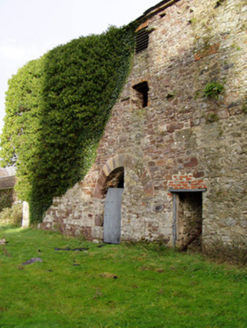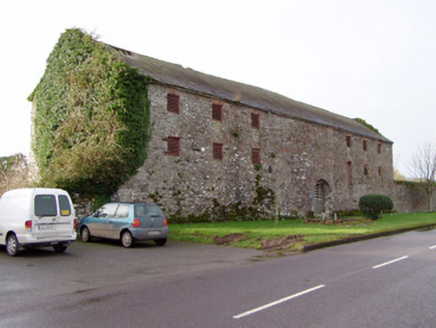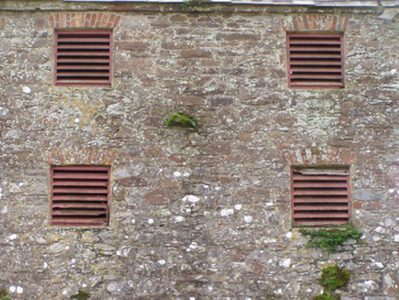Survey Data
Reg No
20804013
Rating
Regional
Categories of Special Interest
Architectural
Original Use
Store/warehouse
Date
1820 - 1840
Coordinates
184140, 92688
Date Recorded
04/10/2006
Date Updated
--/--/--
Description
Detached nine-bay three-storey warehouse with integral carriage arch entrance, built c. 1830, having six-bay single-storey building continuing front elevation at north end. Now disused. Pitched slate roof with clay ridge tiles, having slight stone bracket course. Coursed sandstone rubble walls, with larger lightly tooled sandstone quoins. Camber-headed window openings having brick heads and timber louvers. Two bays of blocked openings to centre. Round-headed integral carriage arch to street (east) elevation, having temporary timber fittings and tooled sandstone voussoirs. Pair of round-headed door openings having tooled stone voussoirs and rubble stone voussoirs to rear, one opening half blocked, and both having corrugated-iron doors. Square-headed door opening to rear having red brick in facer bond over inserted iron lintel. Cast-iron circular tie-plate to front elevation. Northern building has some loop window openings, round-headed blocked door openings with sandstone rubble voussoirs and square-headed door opening having inserted iron lintel. Boundary wall to north elevation, of coursed sandstone rubble terminating in square-plan piers with wrought-iron gate. Two-bay single-storey outbuilding to north with lean-to corrugated-iron roof, coursed sandstone rubble walls and having loop window opening to south side and square-headed door openings to west elevation. Building overlooked by ruins of Castlelyons Castle.
Appraisal
This building, with its regularly spaced windows and unadorned walls, is more typical of a watermill or warehouse. It is distinguished by its round-headed doorways, front and back, with tooled voussoirs and rubble sandstone voussoirs, which give the building an individual character emphasized by its large scale. The coursed rubble stone walls of Barrymore Barn reflect those seen though out the village and this building helps to contextualise its architecture, introducing a quasi-industrial element to the otherwise domestic or small-scale commercial streetscape, and forming the foreground for the ruined castle behind.





